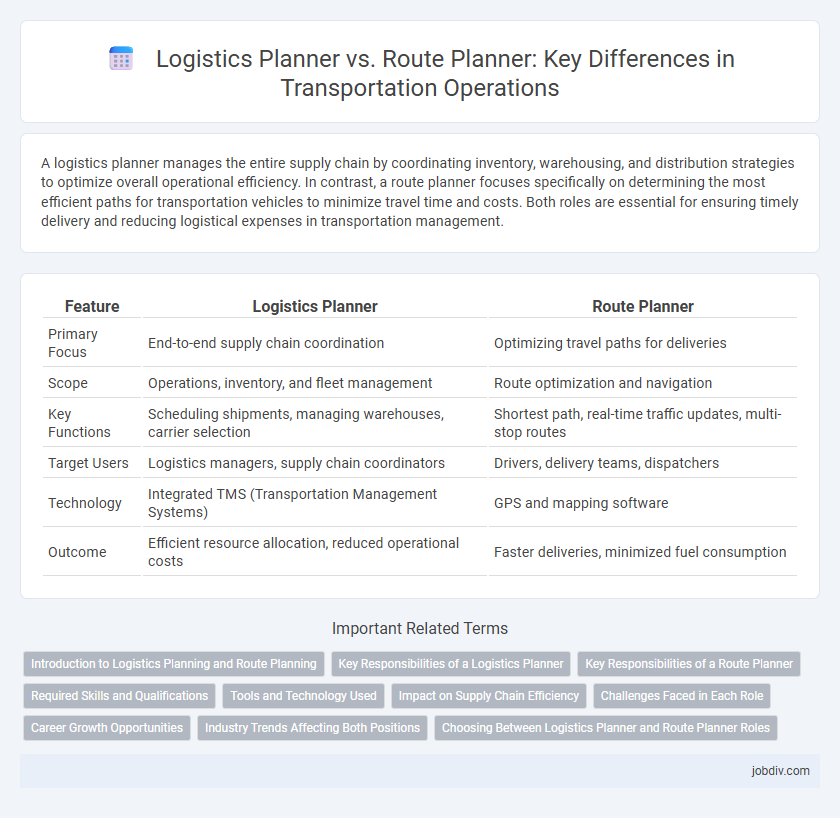A logistics planner manages the entire supply chain by coordinating inventory, warehousing, and distribution strategies to optimize overall operational efficiency. In contrast, a route planner focuses specifically on determining the most efficient paths for transportation vehicles to minimize travel time and costs. Both roles are essential for ensuring timely delivery and reducing logistical expenses in transportation management.
Table of Comparison
| Feature | Logistics Planner | Route Planner |
|---|---|---|
| Primary Focus | End-to-end supply chain coordination | Optimizing travel paths for deliveries |
| Scope | Operations, inventory, and fleet management | Route optimization and navigation |
| Key Functions | Scheduling shipments, managing warehouses, carrier selection | Shortest path, real-time traffic updates, multi-stop routes |
| Target Users | Logistics managers, supply chain coordinators | Drivers, delivery teams, dispatchers |
| Technology | Integrated TMS (Transportation Management Systems) | GPS and mapping software |
| Outcome | Efficient resource allocation, reduced operational costs | Faster deliveries, minimized fuel consumption |
Introduction to Logistics Planning and Route Planning
Logistics planning involves coordinating the entire supply chain process, including inventory management, transportation scheduling, and resource allocation to ensure efficient product delivery. Route planning focuses specifically on determining the most cost-effective and time-efficient paths for vehicles to travel, optimizing fuel consumption and delivery times. Both planners leverage data analytics and GPS technology but differ in scope and operational focus within transportation management.
Key Responsibilities of a Logistics Planner
A Logistics Planner focuses on managing the entire supply chain process, including inventory control, demand forecasting, and coordinating shipments to ensure timely delivery and cost efficiency. They analyze data to optimize warehouse operations and collaborate with procurement, transportation, and customer service teams to align logistics strategies with business goals. Unlike Route Planners who specialize in mapping efficient travel paths, Logistics Planners oversee broader operational planning for end-to-end logistics management.
Key Responsibilities of a Route Planner
A Route Planner focuses on optimizing delivery routes to ensure timely and cost-efficient transportation, using geographic information systems (GIS) and routing software to analyze traffic patterns and vehicle capacity. Key responsibilities include scheduling stops, minimizing fuel consumption, and adapting routes based on real-time conditions such as weather or traffic delays. By improving route efficiency, a Route Planner directly contributes to reducing transportation costs and enhancing customer satisfaction in logistics operations.
Required Skills and Qualifications
A Logistics Planner requires strong analytical skills, proficiency in supply chain management, and expertise in inventory control to optimize overall distribution processes. In contrast, a Route Planner must have deep knowledge of geographic information systems (GIS), route optimization algorithms, and real-time traffic data analysis to design efficient travel paths. Both roles demand excellent problem-solving abilities, attention to detail, and familiarity with transportation management software, but the Logistics Planner emphasizes strategic planning while the Route Planner focuses on tactical routing execution.
Tools and Technology Used
Logistics planners utilize advanced transportation management systems (TMS) and supply chain software to coordinate inventory, warehousing, and shipment schedules efficiently. Route planners focus on GPS-based mapping technologies, real-time traffic data, and routing algorithms to optimize delivery paths and minimize fuel consumption. Both rely on AI-powered analytics and cloud computing to enhance decision-making and streamline operations in transportation management.
Impact on Supply Chain Efficiency
A Logistics Planner optimizes the entire supply chain by coordinating inventory management, warehousing, and transportation strategies to ensure timely delivery and cost reduction. A Route Planner specifically focuses on designing the most efficient delivery paths, minimizing fuel consumption, and reducing transit times for vehicles. Together, these roles enhance supply chain efficiency by aligning strategic planning with tactical execution, leading to improved customer satisfaction and operational agility.
Challenges Faced in Each Role
Logistics planners face challenges in managing complex supply chains, coordinating multiple carriers, and ensuring timely deliveries amid fluctuating demand and regulatory constraints. Route planners struggle with optimizing routes for fuel efficiency, traffic variability, and last-minute order changes while minimizing delivery times and costs. Both roles require advanced analytical tools to address dynamic problems but differ in focus: logistics planners handle broader operational coordination, whereas route planners concentrate on tactical execution of delivery paths.
Career Growth Opportunities
Logistics Planner roles demand expertise in supply chain management and inventory coordination, offering career growth through broader operational leadership positions. Route Planners specialize in optimizing delivery paths using geographic information systems (GIS) and fleet management software, leading to advancement in transport efficiency and regional management roles. Both careers provide pathways to strategic roles, with Logistics Planners often moving into supply chain director roles and Route Planners advancing toward operations manager positions in transportation companies.
Industry Trends Affecting Both Positions
Logistics planners and route planners are increasingly relying on artificial intelligence and machine learning algorithms to enhance efficiency and reduce operational costs. The rise of real-time data analytics and Internet of Things (IoT) integration is driving more accurate demand forecasting and dynamic route optimization, crucial for meeting tight delivery windows. Sustainability trends push both roles to focus on reducing carbon emissions through optimized load distribution and eco-friendly routing strategies.
Choosing Between Logistics Planner and Route Planner Roles
Choosing between a logistics planner and a route planner depends on the scope of responsibilities and operational goals. A logistics planner manages overall supply chain coordination, including inventory, warehousing, and shipment scheduling, while a route planner focuses specifically on optimizing delivery paths for cost and time efficiency. Selecting the right role hinges on whether the priority is comprehensive supply chain management or efficient transportation routing within a logistics network.
Logistics Planner vs Route Planner Infographic

 jobdiv.com
jobdiv.com